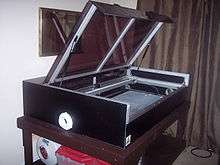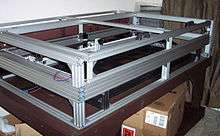Lasersaur



Lasersaur is an open source laser cutter which was developed by NORTD Labs. Nortd Labs started shipping Lasersaur alpha kits in late 2010 after successful funding of the project in July 2010 on Kickstarter.[1] Currently the project is funded via donations from their website or by purchasing part kits.[2]
Specifications
Lasersaur an open source laser cutter which is built by the end user using CAD drawings, circuit schematics, software and a Bill of materials available from NORTD labs. Lasersaur was designed to fill the need of makers, artists and scientists who wanted a safe and highly capable machine.[3] Lasersaurs are built to use 40-200 watt carbon dioxide lasers and to have a bed size of 24 in × 48 in (61 cm × 122 cm).[4]
In the words of co-developer Addie Wagenknecht "This isn’t about building the cheapest machine. We are more interested in building a platform that is sourceable worldwide. We want a platform that is safe, simple to build, reproduce, duplicate and understand. We want you to truly own it, and have access to all the designs that went into it."[5] and "We also are writing open source software and plug-ins from the ground up which will do things you have never seen before (open source software or not)."[6]
Hardware specifications
- overall dimensions (version 12 and later): 1700x1080x350 mm (67x42.6x13.8")
- work area: 1220x610 mm (48x24")
- resolution: 0.1-0.03 mm (240-840dpi)
- maximum seek rate: 20000 mm/min
- maximum feed rate: 10000 mm/min
- cut speed (for 5mm plywood): 2000 mm/min
- etch speed: 4000 mm/min
The Lasersaur is simple to build, using only basic tools (a hand drill, metric hex key set, screwdriver, wire cutter and soldering iron). Construction time varies between a few days to a few months. The unit will cut any dense organic material such as plywood and cloth as well as some plastics such as acrylic glass up to 0.5 in (13 mm) thick (depending on the power of the laser tube selected) with up to 100 µm of accuracy.[7]
Mechanics

The Lasersaur mechanics comprise both stationary and dynamic parts. The primary building blocks of both the frame and the gantry are T-slot aluminum extrusions bolted together with M5 bolts and T-slot nuts. This approach to machine construction is widely used in the automation industry and many suppliers offer compatible parts. The Lasersaur is designed around extrusions with 20, 40 and 80 mm side lengths. All of the mount assemblies are built from angle brackets.
A few parts are custom-cut 6 mm acrylic (or more recently, aluminium) pieces.[6] CAD drawings for the acrylic parts are freely available and can be made using a laser cutter - and should they fail, they may be replaced with spare parts made by the lasersaur itself. Aluminum versions of those parts may be purchased from Nortd labs and are advised for heavy-use machines due to cracking issues with the acrylic parts.

The linear motion assemblies for the x- and y-axis roll directly on anodized aluminum extrusions. No proprietary rails and carriage assemblies are used. The Lasersaur carriages are built from standard-sized ball bearings, cap screws and custom-cut acrylic or metal pieces. Both axes are minimally constrained.[4]
The v13 (and earlier) Lasersaurs use 12-tooth pulleys, 5.08 mm XL belts and 2,000 micro-steps steppers/drivers. This results in a resolution of 0.03 mm/step.[4] The newer v14 (and later) designs used geared-down stepper motors that produce a theoretical resolution of 0.01mm - although in practice, slop in the belts and vibrations in the machine make this number unachievable. With a 100 watt laser tube, kerf widths as low as 0.03mm are possible.
The outer skin of the machine is made from powder-coated sheet steel with polycarbonate panels for the door/lid assembly.
A bay spanning the width of the machine at the rear contains the laser tube and all of the electronics.
The machine has no hardware control panel. The only physical control is the emergency stop button. All other operations are controlled via a web page that's served by the on-board BeagleBone Black control computer, running the Ubuntu linux operating system.
External requirements
- Provision is made for water inlet/outlet for cooling the laser tube - requiring an external water chiller.
- There is a system of air hoses used for providing "air assistance" when cutting thick materials that must be driven either from a small air pump or a large gas cylinder.
- An external smoke extraction/filtration system is required with at least 400 cubic foot (11 m3) per minute capacity and at least 4-inch (10 cm) ducting.
- Prior to version 12.11, an external computer was required to run the "LasaurApp" software, but in version 12.11 and later, this is handled by an onboard computer and all that is required to run the system now is a web browser.
Electronics
In versions of the Lasersaur up to and including v12.08, the hardware is controlled by an Arduino Uno embedded computer with a custom "LasaurShield" card to interface to switches, motors and laser power supply. Two "GeckoDrive" modules are used for stepper motor control and a power relay controls 110/220 V power to the laser power supply. An external computer commands the Arduino via a standard USB interface.
In v12.11 and later, a custom board called "DriveBoard" contains an ATmega328 SoC computer (replacing the Arduino) and all of the drive electronics with the exception of the two GeckoDrive modules and a BeagleBone embedded Linux computer which are attached to it. Interfacing is via an Ethernet cable. There is also experimental support for replacing the BeagleBone with a Raspberry Pi computer and using Nanotec SMC11 stepper motor controllers instead of the GeckoDrive units.
Both LasaurShield and DriveBoard can be purchased from Nortd Labs, but schematics and board layout are publicly available from http://www.lasersaur.com/manual/model.
Software
From an end-user perspective, the web-based interface allows for uploading of SVG files to the Lasersaur and control of feed-rates and laser power for cutting and/or etching of the material depending on the colors used to draw the various lines and curves in the SVG file. Conventionally, red lines are used for cutting and blue or black for etching - but the software supports arbitrary choices in this regard. There is also rudimentary support for loading raw G-code and DXF files.
- A "Direct Control" panel permits one to "home" the cutting head and to position it manually with the mouse, and to monitor the state of the various limit and safety monitoring switches. From version 13, you can also reposition the origin to any location on the bed of the machine
- A "Laser Jobs" panel provides basic queuing of tasks and a small "library" of test patterns.
The Lasersaur software is split into three parts, all of which are Open sourced:
- Firmware: The "LasaurGrbl" software which runs on the Atmega328 to convert commands sent to it in a subset of G-code into stepper motor drive signals for the GeckoDrive modules. LasaurGrbl is written in C++.
- Back end: The "LasaurApp" software which acts as a web server and takes commands and SVG files over the Internet and converts them into G-code for onward transmission to LasaurGrbl. In v12.11 and later, this software runs on the embedded Linux computer inside the Lasersaur. In earlier versions, it runs on an external computer under Linux, MacOS or Windows. LasaurApp is written in Python.
- Front end: A web-page containing the user-interface for LasaurApp, written in HTML and JavaScript.
The front end web interface is served up by the LasaurApp code using the 'bottle' web framework. The LasaurGrbl code can be compiled and loaded into the Atmega CPU via the web interface, so all that's required to install new versions of the software is to place it into the correct folder on the BeagleBone computer.
Successful builds
Current worldwide Lasersaur builds can be viewed on their map page. As of January 2015, there were over 60 entries listed, mostly in Europe, the US, and Canada. Lasersaur systems have also been built by many universities such as Rice University[8] ,[9] University of Limerick,[10] NYU, Stanford, and Carnegie Mellon.
At least one lasersaur (named "The Death ray of Ming the Merciless"), owned by Renaissance Miniatures, has been in service for over 6,500 operating hours with minimal problems.[11]
References
- ↑ "Lasersaur: Open Source Laser Cutter by nortd — Kickstarter". Kickstarter.com. Retrieved 2013-08-01.
- ↑ "Lasersaur by Nortd Labs". Lasersaur.com. Retrieved 2013-08-01.
- ↑ "Lasersaur by Nortd Labs". Labs.nortd.com. Retrieved 2013-08-01.
- 1 2 3 "Lasersaur Manual - overview". Labs.nortd.com. 2013-02-24. Retrieved 2013-08-01.
- ↑ "Lasersaur, an open source laser cutter, is nearing completion". http://libregraphicsworld.org. 2011-12-02. Retrieved 2013-10-10. External link in
|publisher=(help) - 1 2 "MAKE | Interview: Lasersaur's Addie Wagenknecht". Blog.makezine.com. 2010-06-03. Retrieved 2013-08-01.
- ↑ McCue, New Open Source Laser Cutter Hits Market, Forbes, retrieved 2012-05-23
- ↑ "State-of-the-Art Open-Source Laser Cutter Built by University Students". http://www.scienceworldreport.com. 2013-09-17. Retrieved 2013-10-10. External link in
|publisher=(help) - ↑ "Rice Lasersaur". weebly.com. Retrieved 2013-10-10.
- ↑ "Lasersaur (open source laser cutter) assembly timelapse. Feb 2013". vimeo.com. 2013-01-12. Retrieved 2013-10-10.
- ↑ "About Renaissance Miniatures". Renaissance Miniatures. 2014-05-07. Retrieved 2014-05-07.
External links
| Wikimedia Commons has media related to Lasersaur. |